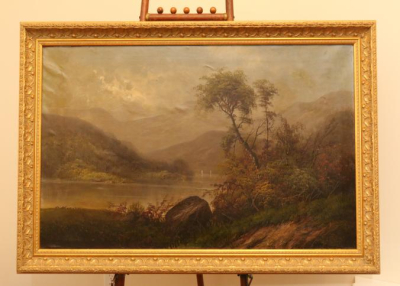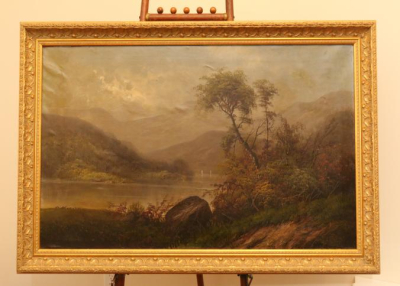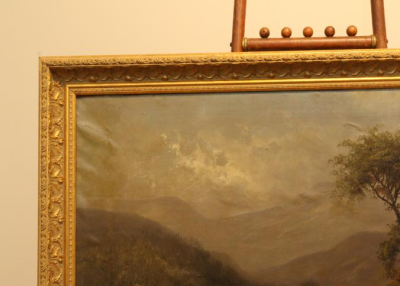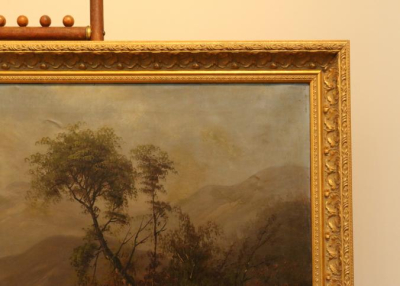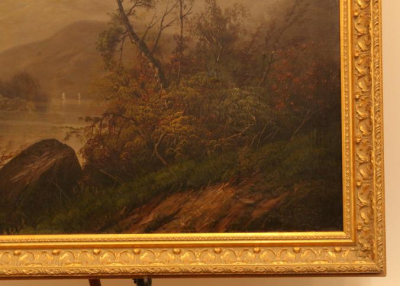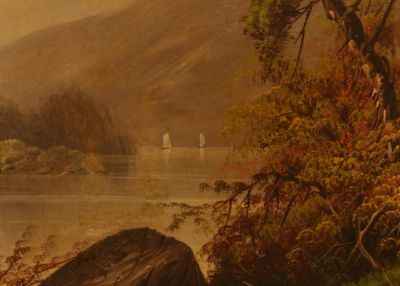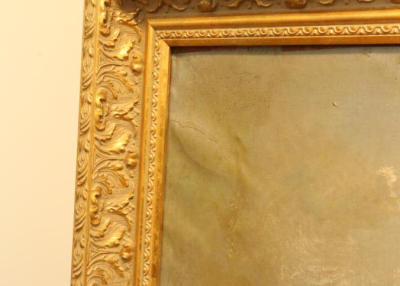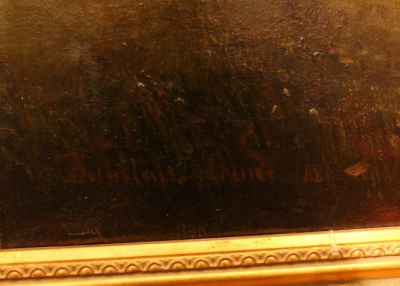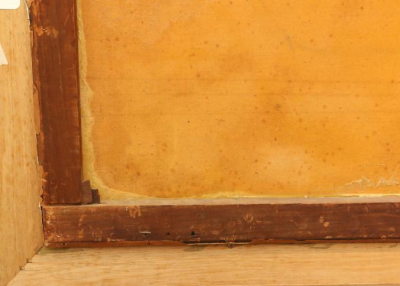Items located in Pleasant Valley, NY. Items include Hudson River School artwork, seascapes and framed lithographs. The Hudson River School of "Nature Painters" were painting from the mid-19ThC to the late 19thC. Although, they were actively painting views all across America, the scenes on the Hudson River are the most sought after. You have a rare opportunity to purchase these great "Views" now in this no-reserve auction. We also encourage you to come see us and preview the auction in-person.
Payment is due by Tuesday, May 23 at 3PM.
Pickup in Pleasant Valley, NY must be completed by Thursday, May 25 at 3PM.
All lots sold as is, where is. There is a 15% Buyers Premium for all lots purchased. Payment methods include cash, PayPal, MC, Visa, Discover or good check. You can make credit card payment online by going to your Member Area and selecting your invoice. To pay by PayPal, send money to info@aarauctions.com.
Payment is due by Tuesday, May 23 at 3PM.
Pickup in Pleasant Valley, NY must be completed by Thursday, May 25 at 3PM.
All lots sold as is, where is. There is a 15% Buyers Premium for all lots purchased. Payment methods include cash, PayPal, MC, Visa, Discover or good check. You can make credit card payment online by going to your Member Area and selecting your invoice. To pay by PayPal, send money to info@aarauctions.com.
Auction Info
Items located in Pleasant Valley, NY. Items include Hudson River School artwork, seascapes and framed lithographs. The Hudson River School of "Nature Painters" were painting from the mid-19ThC to the late 19thC. Although, they were actively painting views all across America, the scenes on the Hudson River are the most sought after. You have a rare opportunity to purchase these great "Views" now in this no-reserve auction. We also encourage you to come see us and preview the auction in-person.
Payment is due by Tuesday, May 23 at 3PM.
Pickup in Pleasant Valley, NY must be completed by Thursday, May 25 at 3PM.
All lots sold as is, where is. There is a 15% Buyers Premium for all lots purchased. Payment methods include cash, PayPal, MC, Visa, Discover or good check. You can make credit card payment online by going to your Member Area and selecting your invoice. To pay by PayPal, send money to info@aarauctions.com.
Payment is due by Tuesday, May 23 at 3PM.
Pickup in Pleasant Valley, NY must be completed by Thursday, May 25 at 3PM.
All lots sold as is, where is. There is a 15% Buyers Premium for all lots purchased. Payment methods include cash, PayPal, MC, Visa, Discover or good check. You can make credit card payment online by going to your Member Area and selecting your invoice. To pay by PayPal, send money to info@aarauctions.com.
Categories:
Framed 19thC o/c signed "Edmund Darch Lewis" (1835-1910). Hudson river View w/sailboat. Bio AskArt: One of the most prolific and commercially successful American landscape painters of the late nineteenth century, Edmund Darch Lewis rendered crisply realistic images of shorelines, waterways, and rural scenes in the northeast that received popular acclaim during his era.
Lewis was born in Philadelphia. At age fifteen, he began to study art, enrolling in a private class with Paul Weber. His initial works were landscapes and marine views, focusing on the Lehigh, Susauehana, and Wissahickon Rivers of Pennsylvania. These paintings were described in the Philadelphia Public Ledger as demonstrating "a tremendous talent, great freedom from tradition," and they "promised a departure from the beaten tracks." Lewis's art was in high demand from the beginning of his career and he established a national following.
Although he became best known for scenes of Philadelphia, Lewis also rendered views of New York, New England, and even Cuba. Later in his career, his focus shifted to shorelines of Cape May, New Jersey, and Narragansett, Rhode Island. He frequently depicted schooners drifting in calm waters, churning mills, and hidden cottages. Lewis favored watercolor, but also used oils and gouache.
Due to his financial success in painting, Lewis was able to nurture his passion for collecting. He would often trade a group of his watercolors for valuable objects d'art. His collection included a throne that belonged to Napoleon I, a set of drawing room furniture from the Borghese Palace in Rome, and the original sketch for Alexandre Cabanel's Birth of Venus. His mansion in Philadelphia consisted of two connecting houses and additional annexes that were filled with period furniture, china, and decorative arts. Wealthy and admired, Lewis entertained in a grand style, hosting a number of exhibitions and events in his opulent home.
Lewis exhibited at the Pennsylvania Academy of the Fine Arts (1854-69) and was elected an associate of the Academy in 1859. He also showed at the National Academy of Design in New York (1860), the Boston Athenaeum (1858-69), and the Brooklyn Art Association (1862-70).
Lewis's work is in several public collections including the Mobile Museum of Art, Alabama; Cummer Museum of Art and Gardens, Jacksonville, Florida; Worcester Art Museum, Massachusetts; Frederic Remington Art Museum, Ogdensburg, New York; and the National Cowboy and Western Heritage Museum, Oklahoma City, Oklahoma 21.5" x 35.5" sight, 22" x 36" canvas
More Details
Framed 19thC o/c signed "Edmund Darch Lewis" (1835-1910). Hudson river View w/sailboat. Bio AskArt: One of the most prolific and commercially successful American landscape painters of the late nineteenth century, Edmund Darch Lewis rendered crisply realistic images of shorelines, waterways, and rural scenes in the northeast that received popular acclaim during his era.
Lewis was born in Philadelphia. At age fifteen, he began to study art, enrolling in a private class with Paul Weber. His initial works were landscapes and marine views, focusing on the Lehigh, Susauehana, and Wissahickon Rivers of Pennsylvania. These paintings were described in the Philadelphia Public Ledger as demonstrating "a tremendous talent, great freedom from tradition," and they "promised a departure from the beaten tracks." Lewis's art was in high demand from the beginning of his career and he established a national following.
Although he became best known for scenes of Philadelphia, Lewis also rendered views of New York, New England, and even Cuba. Later in his career, his focus shifted to shorelines of Cape May, New Jersey, and Narragansett, Rhode Island. He frequently depicted schooners drifting in calm waters, churning mills, and hidden cottages. Lewis favored watercolor, but also used oils and gouache.
Due to his financial success in painting, Lewis was able to nurture his passion for collecting. He would often trade a group of his watercolors for valuable objects d'art. His collection included a throne that belonged to Napoleon I, a set of drawing room furniture from the Borghese Palace in Rome, and the original sketch for Alexandre Cabanel's Birth of Venus. His mansion in Philadelphia consisted of two connecting houses and additional annexes that were filled with period furniture, china, and decorative arts. Wealthy and admired, Lewis entertained in a grand style, hosting a number of exhibitions and events in his opulent home.
Lewis exhibited at the Pennsylvania Academy of the Fine Arts (1854-69) and was elected an associate of the Academy in 1859. He also showed at the National Academy of Design in New York (1860), the Boston Athenaeum (1858-69), and the Brooklyn Art Association (1862-70).
Lewis's work is in several public collections including the Mobile Museum of Art, Alabama; Cummer Museum of Art and Gardens, Jacksonville, Florida; Worcester Art Museum, Massachusetts; Frederic Remington Art Museum, Ogdensburg, New York; and the National Cowboy and Western Heritage Museum, Oklahoma City, Oklahoma 21.5" x 35.5" sight, 22" x 36" canvas
High Bid:
$1,850.00 – sailfin
Auction Type: One Lot
Quantity: 1
Bidding has closed on this lot

